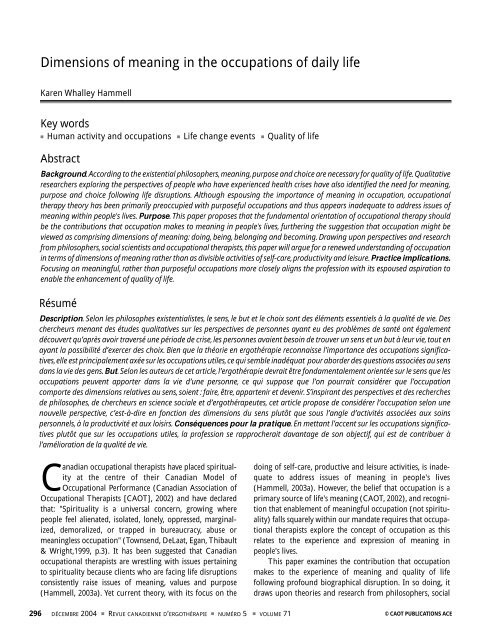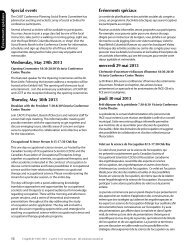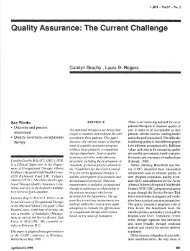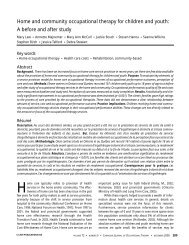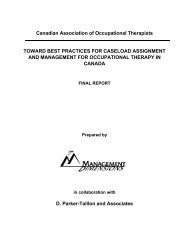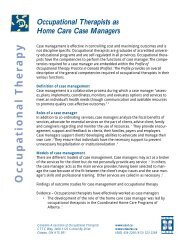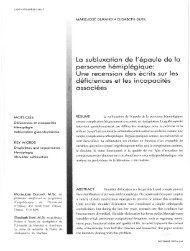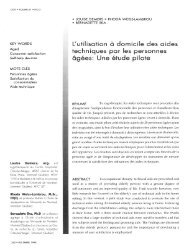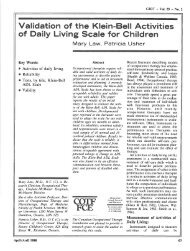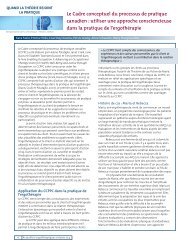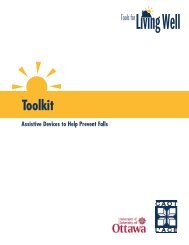Dimensions of meaning in the occupations of daily life - Canadian ...
Dimensions of meaning in the occupations of daily life - Canadian ...
Dimensions of meaning in the occupations of daily life - Canadian ...
Create successful ePaper yourself
Turn your PDF publications into a flip-book with our unique Google optimized e-Paper software.
<strong>Dimensions</strong> <strong>of</strong> <strong>mean<strong>in</strong>g</strong> <strong>in</strong> <strong>the</strong> <strong>occupations</strong> <strong>of</strong> <strong>daily</strong> <strong>life</strong><br />
Karen Whalley Hammell<br />
Key words<br />
■ Human activity and <strong>occupations</strong> ■ Life change events ■ Quality <strong>of</strong> <strong>life</strong><br />
Abstract<br />
Background. Accord<strong>in</strong>g to <strong>the</strong> existential philosophers, <strong>mean<strong>in</strong>g</strong>, purpose and choice are necessary for quality <strong>of</strong> <strong>life</strong>. Qualitative<br />
researchers explor<strong>in</strong>g <strong>the</strong> perspectives <strong>of</strong> people who have experienced health crises have also identified <strong>the</strong> need for <strong>mean<strong>in</strong>g</strong>,<br />
purpose and choice follow<strong>in</strong>g <strong>life</strong> disruptions. Although espous<strong>in</strong>g <strong>the</strong> importance <strong>of</strong> <strong>mean<strong>in</strong>g</strong> <strong>in</strong> occupation, occupational<br />
<strong>the</strong>rapy <strong>the</strong>ory has been primarily preoccupied with purposeful <strong>occupations</strong> and thus appears <strong>in</strong>adequate to address issues <strong>of</strong><br />
<strong>mean<strong>in</strong>g</strong> with<strong>in</strong> people's lives. Purpose. This paper proposes that <strong>the</strong> fundamental orientation <strong>of</strong> occupational <strong>the</strong>rapy should<br />
be <strong>the</strong> contributions that occupation makes to <strong>mean<strong>in</strong>g</strong> <strong>in</strong> people's lives, fur<strong>the</strong>r<strong>in</strong>g <strong>the</strong> suggestion that occupation might be<br />
viewed as compris<strong>in</strong>g dimensions <strong>of</strong> <strong>mean<strong>in</strong>g</strong>: do<strong>in</strong>g, be<strong>in</strong>g, belong<strong>in</strong>g and becom<strong>in</strong>g. Draw<strong>in</strong>g upon perspectives and research<br />
from philosophers, social scientists and occupational <strong>the</strong>rapists, this paper will argue for a renewed understand<strong>in</strong>g <strong>of</strong> occupation<br />
<strong>in</strong> terms <strong>of</strong> dimensions <strong>of</strong> <strong>mean<strong>in</strong>g</strong> ra<strong>the</strong>r than as divisible activities <strong>of</strong> self-care, productivity and leisure. Practice implications.<br />
Focus<strong>in</strong>g on <strong>mean<strong>in</strong>g</strong>ful, ra<strong>the</strong>r than purposeful <strong>occupations</strong> more closely aligns <strong>the</strong> pr<strong>of</strong>ession with its espoused aspiration to<br />
enable <strong>the</strong> enhancement <strong>of</strong> quality <strong>of</strong> <strong>life</strong>.<br />
Résumé<br />
Description. Selon les philosophes existentialistes, le sens, le but et le choix sont des éléments essentiels à la qualité de vie. Des<br />
chercheurs menant des études qualitatives sur les perspectives de personnes ayant eu des problèmes de santé ont également<br />
découvert qu’après avoir traversé une période de crise, les personnes avaient beso<strong>in</strong> de trouver un sens et un but à leur vie, tout en<br />
ayant la possibilité d’exercer des choix. Bien que la théorie en ergothérapie reconnaisse l’importance des <strong>occupations</strong> significatives,<br />
elle est pr<strong>in</strong>cipalement axée sur les <strong>occupations</strong> utiles, ce qui semble <strong>in</strong>adéquat pour aborder des questions associées au sens<br />
dans la vie des gens. But. Selon les auteurs de cet article, l’ergothérapie devrait être fondamentalement orientée sur le sens que les<br />
<strong>occupations</strong> peuvent apporter dans la vie d’une personne, ce qui suppose que l’on pourrait considérer que l’occupation<br />
comporte des dimensions relatives au sens, soient : faire, être, appartenir et devenir. S’<strong>in</strong>spirant des perspectives et des recherches<br />
de philosophes, de chercheurs en science sociale et d’ergothérapeutes, cet article propose de considérer l’occupation selon une<br />
nouvelle perspective, c’est-à-dire en fonction des dimensions du sens plutôt que sous l’angle d’activités associées aux so<strong>in</strong>s<br />
personnels, à la productivité et aux loisirs. Conséquences pour la pratique. En mettant l’accent sur les <strong>occupations</strong> significatives<br />
plutôt que sur les <strong>occupations</strong> utiles, la pr<strong>of</strong>ession se rapprocherait davantage de son objectif, qui est de contribuer à<br />
l’amélioration de la qualité de vie.<br />
<strong>Canadian</strong> occupational <strong>the</strong>rapists have placed spirituality<br />
at <strong>the</strong> centre <strong>of</strong> <strong>the</strong>ir <strong>Canadian</strong> Model <strong>of</strong><br />
Occupational Performance (<strong>Canadian</strong> Association <strong>of</strong><br />
Occupational Therapists [CAOT], 2002) and have declared<br />
that: "Spirituality is a universal concern, grow<strong>in</strong>g where<br />
people feel alienated, isolated, lonely, oppressed, marg<strong>in</strong>alized,<br />
demoralized, or trapped <strong>in</strong> bureaucracy, abuse or<br />
<strong>mean<strong>in</strong>g</strong>less occupation" (Townsend, DeLaat, Egan, Thibault<br />
& Wright,1999, p.3). It has been suggested that <strong>Canadian</strong><br />
occupational <strong>the</strong>rapists are wrestl<strong>in</strong>g with issues perta<strong>in</strong><strong>in</strong>g<br />
to spirituality because clients who are fac<strong>in</strong>g <strong>life</strong> disruptions<br />
consistently raise issues <strong>of</strong> <strong>mean<strong>in</strong>g</strong>, values and purpose<br />
(Hammell, 2003a). Yet current <strong>the</strong>ory, with its focus on <strong>the</strong><br />
296 DÉCEMBRE 2004 ■ REVUE CANADIENNE D’ERGOTHÉRAPIE ■ NUMÉRO 5 ■ VOLUME 71<br />
do<strong>in</strong>g <strong>of</strong> self-care, productive and leisure activities, is <strong>in</strong>adequate<br />
to address issues <strong>of</strong> <strong>mean<strong>in</strong>g</strong> <strong>in</strong> people's lives<br />
(Hammell, 2003a). However, <strong>the</strong> belief that occupation is a<br />
primary source <strong>of</strong> <strong>life</strong>'s <strong>mean<strong>in</strong>g</strong> (CAOT, 2002), and recognition<br />
that enablement <strong>of</strong> <strong>mean<strong>in</strong>g</strong>ful occupation (not spirituality)<br />
falls squarely with<strong>in</strong> our mandate requires that occupational<br />
<strong>the</strong>rapists explore <strong>the</strong> concept <strong>of</strong> occupation as this<br />
relates to <strong>the</strong> experience and expression <strong>of</strong> <strong>mean<strong>in</strong>g</strong> <strong>in</strong><br />
people's lives.<br />
This paper exam<strong>in</strong>es <strong>the</strong> contribution that occupation<br />
makes to <strong>the</strong> experience <strong>of</strong> <strong>mean<strong>in</strong>g</strong> and quality <strong>of</strong> <strong>life</strong><br />
follow<strong>in</strong>g pr<strong>of</strong>ound biographical disruption. In so do<strong>in</strong>g, it<br />
draws upon <strong>the</strong>ories and research from philosophers, social<br />
© CAOT PUBLICATIONS ACE
scientists and occupational <strong>the</strong>rapists to support an alternate<br />
vision for <strong>the</strong>oriz<strong>in</strong>g occupation <strong>in</strong> terms <strong>of</strong> "<strong>the</strong> sources <strong>of</strong><br />
<strong>mean<strong>in</strong>g</strong> found <strong>in</strong> occupation and <strong>the</strong> contributions that<br />
occupation makes to <strong>mean<strong>in</strong>g</strong> <strong>in</strong> our lives" (Hasselkus,<br />
2002,p.xi).<br />
The concept <strong>of</strong> occupation <strong>in</strong><br />
occupational <strong>the</strong>rapy <strong>the</strong>ory<br />
Current occupational <strong>the</strong>rapy <strong>the</strong>ory states that occupation<br />
"is everyth<strong>in</strong>g people do to occupy <strong>the</strong>mselves, <strong>in</strong>clud<strong>in</strong>g<br />
look<strong>in</strong>g after <strong>the</strong>mselves (self-care), enjoy<strong>in</strong>g <strong>life</strong> (leisure),<br />
and contribut<strong>in</strong>g to <strong>the</strong> social and economic fabric <strong>of</strong> <strong>the</strong>ir<br />
communities (productivity)" (CAOT, 2002, p.34). This<br />
def<strong>in</strong>ition does not delimit occupation to three categories but<br />
subsequent statements <strong>in</strong> <strong>the</strong> same publication list <strong>the</strong><br />
"purposes" <strong>of</strong> occupation as be<strong>in</strong>g self-care, productivity and<br />
leisure (CAOT, 2002,p.37). This is nei<strong>the</strong>r a random nor an<br />
alphabetical order<strong>in</strong>g (Suto, 2004), but a hierarchy that<br />
reflects <strong>the</strong> specific values and priorities <strong>of</strong> physically<br />
<strong>in</strong>dependent, employed <strong>the</strong>orists (Hammell, 2004a). Some<br />
disability <strong>the</strong>orists would argue that by prioritiz<strong>in</strong>g self-care<br />
and productive (economic) activities, occupational <strong>the</strong>rapists<br />
act as agents <strong>of</strong> <strong>the</strong> state, actively perpetuat<strong>in</strong>g ideologies that<br />
denigrate those deemed dependent or unproductive<br />
(Hammell, 2004b). Indeed, categoriz<strong>in</strong>g <strong>the</strong> <strong>occupations</strong> <strong>of</strong><br />
o<strong>the</strong>rs is not a neutral enterprise but value-laden and <strong>in</strong>herently<br />
political: "The labels attached to activities establish and<br />
justify <strong>the</strong>ir social worth" (Devault, 1990, p.110).<br />
The categorisation <strong>of</strong> <strong>occupations</strong> <strong>in</strong>to three divisions is<br />
problematic for o<strong>the</strong>r reasons. Some <strong>of</strong> <strong>the</strong> most <strong>mean<strong>in</strong>g</strong>ful<br />
<strong>occupations</strong> cannot be made to fit any <strong>of</strong> <strong>the</strong> three categories.<br />
For example, car<strong>in</strong>g for one's children, partner, parents or<br />
companion animals; simply be<strong>in</strong>g with special people or<br />
physically express<strong>in</strong>g love are not self-care activities, nor are<br />
<strong>the</strong>y necessarily socially or economically productive or experienced<br />
as leisure (a word which has few equivalents <strong>in</strong> o<strong>the</strong>r<br />
languages) (Kelly & Kelly, 1994). Ra<strong>the</strong>r, <strong>the</strong>y are an expression<br />
through occupation (time, energy, <strong>in</strong>terest) <strong>of</strong> someth<strong>in</strong>g<br />
much more important: <strong>of</strong> a connectedness and <strong>of</strong> a<br />
shar<strong>in</strong>g <strong>of</strong> oneself.<br />
Fur<strong>the</strong>r, due to age, culture, socioeconomic status or<br />
<strong>life</strong>style, an occupation may be labelled by some people as<br />
leisure and by o<strong>the</strong>rs as productive. Indeed, <strong>the</strong> perception <strong>of</strong><br />
a leisure/work dichotomy is not universal, but ra<strong>the</strong>r, culturally<br />
specific (Primeau, 1996). Moreover, <strong>the</strong> same <strong>in</strong>dividual<br />
may def<strong>in</strong>e an occupation differently at different times,<br />
dependent upon mood, goals, context and <strong>the</strong> presence <strong>of</strong><br />
o<strong>the</strong>r people (CAOT, 2002; Kelly & Kelly, 1994; Primeau,<br />
1996; Shaw, 1984). Thus, "it is impossible to give an <strong>in</strong>dividual's<br />
occupation any <strong>mean<strong>in</strong>g</strong> o<strong>the</strong>r than <strong>the</strong> subjective<br />
<strong>mean<strong>in</strong>g</strong> that <strong>the</strong>y, <strong>the</strong>mselves, choose to give it" (We<strong>in</strong>blatt<br />
& Avrech-Bar, 2001, p.169). Because <strong>the</strong> three categories are<br />
© CAOT PUBLICATIONS ACE<br />
HAMMELL<br />
unstable, establish<strong>in</strong>g an optimal balance among <strong>the</strong>m is<br />
problematic, yet as Christiansen (1996) has stated: "One <strong>of</strong><br />
<strong>the</strong> most widely cited philosophical beliefs <strong>in</strong> occupational<br />
<strong>the</strong>rapy is that a balance <strong>of</strong> <strong>occupations</strong> is beneficial to health<br />
and well-be<strong>in</strong>g" (p.432).<br />
The notion <strong>of</strong> balance is also problematic. While this<br />
assumption may be valid, it "fails to def<strong>in</strong>e work, leisure, or<br />
what constitutes a balance; does not specify <strong>the</strong> aspects <strong>of</strong><br />
health that are promoted; and is not seriously subjected to<br />
<strong>the</strong> possibility <strong>of</strong> disconfirmation" (Clark et al., 1991, p.306).<br />
Nei<strong>the</strong>r is it clear who is privileged to determ<strong>in</strong>e balance or<br />
imbalance, nor whose values <strong>the</strong>se judgements might reflect.<br />
In addition, <strong>the</strong> idea that one can engage <strong>in</strong> one occupation<br />
at a time (a clear requirement for classification) represents a<br />
particularly ableist stance. Ableism refers to social practices<br />
and relations that assume and privilege able-bodiedness.<br />
Engag<strong>in</strong>g <strong>in</strong> one occupation at a time may be impossible for<br />
those people with severe physical impairments for whom<br />
self-care activities <strong>in</strong>trude <strong>in</strong>to every o<strong>the</strong>r occupation<br />
(Hammell, 2004a).<br />
Occupational <strong>the</strong>rapy <strong>the</strong>ory has demonstrated a clear<br />
difficulty with differentiat<strong>in</strong>g between <strong>the</strong> concepts purposeful<br />
and <strong>mean<strong>in</strong>g</strong>ful, sometimes us<strong>in</strong>g <strong>the</strong> terms <strong>in</strong>terchangeably<br />
and tend<strong>in</strong>g to extol <strong>the</strong> notion <strong>of</strong> <strong>mean<strong>in</strong>g</strong>ful occupation<br />
while focus<strong>in</strong>g <strong>in</strong>stead on purposeful, goal-oriented, sociallysanctioned<br />
use <strong>of</strong> time and energy <strong>in</strong> do<strong>in</strong>g (e.g. Christiansen<br />
& Baum, 1997; Wilcock, 1993, 1998a; Yerxa, 1998; Yerxa et al.,<br />
1989). It is stated that: "Occupations are <strong>mean<strong>in</strong>g</strong>ful to people<br />
when <strong>the</strong>y fulfil a goal or purpose that is personally or<br />
culturally important" (CAOT, 2002, p.36). This implies that<br />
<strong>mean<strong>in</strong>g</strong>ful is a positive term, yet all <strong>occupations</strong> are <strong>mean<strong>in</strong>g</strong>ful;<br />
<strong>the</strong>y all have some <strong>mean<strong>in</strong>g</strong> for <strong>the</strong> <strong>in</strong>dividual engaged<br />
<strong>in</strong> <strong>the</strong>m. When <strong>occupations</strong> are dictated by <strong>the</strong> agendas <strong>of</strong><br />
occupational <strong>the</strong>rapists for example, <strong>the</strong> <strong>mean<strong>in</strong>g</strong> clients<br />
derive from <strong>the</strong>m can be "humiliat<strong>in</strong>g" (Helfrich &<br />
Kielh<strong>of</strong>ner, 1994,p.321).<br />
The current triad <strong>of</strong> privileged <strong>occupations</strong> has only<br />
partial resonance with <strong>the</strong> experiences <strong>of</strong> people whose lives<br />
have been disrupted, for example by impairment or illness,<br />
war, unemployment, bereavement or geographic dislocation.<br />
However, recent <strong>in</strong>corporation <strong>of</strong> qualitative methods <strong>in</strong>to<br />
occupational <strong>the</strong>rapy research has enabled <strong>the</strong> exploration <strong>of</strong><br />
different ways <strong>of</strong> understand<strong>in</strong>g occupation and disruption,<br />
creat<strong>in</strong>g <strong>the</strong> possibility for <strong>the</strong> perspectives <strong>of</strong> various client<br />
groups to <strong>in</strong>filtrate pr<strong>of</strong>essional <strong>the</strong>ory. Consistent <strong>the</strong>mes<br />
across diverse studies suggest that occupation might best be<br />
understood, not as divisible activities <strong>of</strong> self-care, productivity<br />
and leisure but as dimensions <strong>of</strong> <strong>mean<strong>in</strong>g</strong>.<br />
Law et al. (1996, p.16) state that <strong>occupations</strong> meet <strong>the</strong><br />
person's "<strong>in</strong>tr<strong>in</strong>sic needs for self-ma<strong>in</strong>tenance, expression<br />
and fulfilment"; suggest<strong>in</strong>g that <strong>occupations</strong> might usefully<br />
be explored, not <strong>in</strong> terms <strong>of</strong> categories, but <strong>in</strong> terms <strong>of</strong><br />
how <strong>the</strong>y meet <strong>in</strong>tr<strong>in</strong>sic needs. Congruent with <strong>the</strong> goal <strong>of</strong><br />
VOLUME 71 ■ NUMBER 5 ■ CANADIAN JOURNAL OF OCCUPATIONAL THERAPY ■ DECEMBER 2004 297
HAMMELL<br />
explor<strong>in</strong>g how <strong>occupations</strong> meet people's <strong>in</strong>tr<strong>in</strong>sic needs,<br />
<strong>the</strong> follow<strong>in</strong>g section will exam<strong>in</strong>e <strong>mean<strong>in</strong>g</strong> with<strong>in</strong> <strong>life</strong><br />
disruptions.<br />
Biographical disruption:<br />
Consequences and significance<br />
Mus<strong>in</strong>g upon <strong>the</strong> accident <strong>in</strong> which he damaged his sp<strong>in</strong>al<br />
cord, Hockenberry (1995) wrote: "Until ... that day <strong>in</strong> 1976 I<br />
understood <strong>the</strong> world only as an evolv<strong>in</strong>g landscape <strong>of</strong><br />
clockwork challenges and gradual change. I would grow up. I<br />
would graduate. I would have a career. I would be happy"<br />
(p.24). The sense <strong>of</strong> disruption to expectations, <strong>life</strong>-plans and<br />
"<strong>the</strong> seductive predictability" <strong>of</strong> every day <strong>life</strong> (Hockenberry,<br />
1995, p.79) is a recurr<strong>in</strong>g <strong>the</strong>me <strong>in</strong> <strong>the</strong> <strong>life</strong> narratives <strong>of</strong><br />
people who have experienced unexpected <strong>life</strong> events (Becker,<br />
1997; Reynolds, 2003) and has been termed biographical<br />
disruption (Bury, 1982).<br />
In <strong>the</strong> context <strong>of</strong> health crises, biographical disruption<br />
has been described as compris<strong>in</strong>g three dimensions: body,<br />
conceptions <strong>of</strong> self, and time. This <strong>the</strong>ory suggests that illness<br />
or <strong>in</strong>jury that leads to an <strong>in</strong>ability to perform valued activities<br />
<strong>of</strong> every day <strong>life</strong> may lead to a loss <strong>of</strong> certa<strong>in</strong> aspects <strong>of</strong> <strong>the</strong><br />
self, such as perceptions <strong>of</strong> competence, self-worth and<br />
identity (Corb<strong>in</strong> & Strauss, 1987). This suggestion has been<br />
supported by qualitative researchers, who have identified<br />
perceptions <strong>of</strong> dim<strong>in</strong>ished self-worth among those for whom<br />
bodily dysfunction has disrupted formerly taken for granted<br />
<strong>daily</strong> rout<strong>in</strong>es, roles and valued <strong>occupations</strong> (Carricaburu &<br />
Pierret, 1995; Duggan & Dijkers, 1999; Hammell, 1998a;<br />
Reynolds, 2003; Sanders, Donovan & Dieppe, 2002; Vrkljan &<br />
Miller Polgar, 2001).<br />
Bury (1991) dist<strong>in</strong>guished two forms <strong>of</strong> <strong>mean<strong>in</strong>g</strong><br />
<strong>of</strong> impairment and both have relevance for <strong>the</strong>ories <strong>of</strong> occupation.<br />
First, he suggested that <strong>the</strong> <strong>mean<strong>in</strong>g</strong> <strong>of</strong> an impairment<br />
will lie <strong>in</strong> its consequences; how it is biographically<br />
disruptive <strong>in</strong> terms <strong>of</strong> its impact on everyday <strong>life</strong> activities and<br />
relationships. The second <strong>mean<strong>in</strong>g</strong> <strong>of</strong> impairment lies <strong>in</strong> its<br />
significance, that is, <strong>in</strong> terms <strong>of</strong> its social connotations. The<br />
significance <strong>of</strong> a given impairment will be dependent upon<br />
cultural ideas concern<strong>in</strong>g causation (blame), stigma, competence<br />
and social worth. In turn, <strong>the</strong>se factors <strong>in</strong>fluence <strong>the</strong><br />
significance <strong>of</strong> an impairment for <strong>the</strong> <strong>in</strong>dividual's sense <strong>of</strong> self.<br />
Any unexpected event <strong>in</strong> <strong>the</strong> seductively predictable flow<br />
<strong>of</strong> <strong>daily</strong> <strong>life</strong>, such as <strong>the</strong> death <strong>of</strong> a <strong>life</strong> partner, a <strong>life</strong>threaten<strong>in</strong>g<br />
illness, a marital breakdown or <strong>the</strong> loss <strong>of</strong> a<br />
valued job, may constitute a biographical disruption. The<br />
consequences <strong>of</strong> disruption are experienced <strong>in</strong> terms <strong>of</strong> <strong>the</strong><br />
loss <strong>of</strong> do<strong>in</strong>g those activities that gave structure and logic,<br />
<strong>mean<strong>in</strong>g</strong> and purpose to <strong>life</strong> (Becker, 1997). Occupational<br />
<strong>the</strong>rapists have tended to focus only on those disruptions<br />
occasioned by illness, <strong>in</strong>jury or impairment, and <strong>the</strong>n only on<br />
<strong>the</strong> consequences <strong>of</strong> those disrupted biographies. However,<br />
sociologists also draw our attention to <strong>the</strong> significance <strong>of</strong><br />
disruption; a dimension that addresses values. Sartre (1956)<br />
claimed that one does not exam<strong>in</strong>e values or <strong>mean<strong>in</strong>g</strong>s when<br />
engaged <strong>in</strong> <strong>the</strong> predictable rout<strong>in</strong>e <strong>of</strong> <strong>daily</strong> activities but<br />
when crisis compels reflection.<br />
Chang<strong>in</strong>g <strong>the</strong> <strong>mean<strong>in</strong>g</strong> <strong>of</strong> consequences<br />
One <strong>of</strong> <strong>the</strong> primary consequences <strong>of</strong> an illness or <strong>in</strong>jury is <strong>the</strong><br />
cessation <strong>of</strong> do<strong>in</strong>g: <strong>the</strong> ability to engage <strong>in</strong> personally <strong>mean<strong>in</strong>g</strong>ful<br />
<strong>occupations</strong> (Hammell, 1998a; Kleiber, Brock, Lee,<br />
Datillo & Caldwell, 1995; Lyons, Orozovic, Davis & Newman,<br />
2002; Vrkljan & Miller Polgar, 2001). Thus impairments are<br />
experienced both physiologically and occupationally<br />
(Hasselkus, 2002).<br />
The biographical disruption occasioned by illness or<br />
<strong>in</strong>jury requires several responses: attention to <strong>the</strong> body,<br />
fundamental re-th<strong>in</strong>k<strong>in</strong>g <strong>of</strong> biography, and mobilisation <strong>of</strong><br />
social and material resources (Bury, 1982). With a supportive<br />
social network and appropriate material resources, forms <strong>of</strong><br />
<strong>life</strong>style can be adopted that enable a shift from an image <strong>of</strong><br />
a disabled self to one <strong>of</strong> a capable self (Corb<strong>in</strong> & Strauss,<br />
1991). There is grow<strong>in</strong>g evidence that many people who have<br />
physical impairments undergo a conceptual transformation,<br />
such that <strong>the</strong>y change <strong>the</strong> way <strong>the</strong>y th<strong>in</strong>k about disability.<br />
Through choos<strong>in</strong>g to m<strong>in</strong>imize losses and focus <strong>in</strong>stead on<br />
abilities and accomplishments, <strong>the</strong>y perceive <strong>the</strong>mselves to be<br />
competent and capable (Carpenter, 1994; Duggan & Dijkers,<br />
1999; Gill, 2001; Hammell, 1998a, 2004a; Keany & Glueckauf,<br />
1993). Indeed, many no longer view <strong>the</strong>mselves as disabled.<br />
As a young man with high tetraplegia observed: "I don't look<br />
at you as able-bodied and me as disabled ... We're [all] do<strong>in</strong>g<br />
<strong>the</strong> best we can with what we have" (Hammell, 1998a).<br />
New <strong>mean<strong>in</strong>g</strong>s <strong>of</strong> <strong>the</strong> concepts able and disabled arise as<br />
people discover ways <strong>of</strong> engag<strong>in</strong>g <strong>in</strong> <strong>mean<strong>in</strong>g</strong>ful <strong>occupations</strong>,<br />
<strong>the</strong>reby challeng<strong>in</strong>g hegemonic social assumptions. Kagawa-<br />
S<strong>in</strong>ger (1993) also observed that people liv<strong>in</strong>g with cancer<br />
redef<strong>in</strong>ed <strong>the</strong> <strong>mean<strong>in</strong>g</strong> <strong>of</strong> health, employ<strong>in</strong>g a def<strong>in</strong>ition<br />
"based upon <strong>the</strong>ir ability to ma<strong>in</strong>ta<strong>in</strong> a sense <strong>of</strong> <strong>in</strong>tegrity as<br />
productive, able, and valued <strong>in</strong>dividuals with<strong>in</strong> <strong>the</strong>ir social<br />
spheres, despite <strong>the</strong>ir physical condition" (p.295). When <strong>the</strong><br />
consequences <strong>of</strong> impairment are altered through engagement<br />
<strong>in</strong> valued <strong>occupations</strong>, both <strong>the</strong> experience and <strong>the</strong> <strong>mean<strong>in</strong>g</strong><br />
<strong>of</strong> disability are altered. Chang<strong>in</strong>g <strong>the</strong> experience <strong>of</strong> a situation<br />
<strong>in</strong> terms <strong>of</strong> its consequences thus serves to change its<br />
<strong>mean<strong>in</strong>g</strong>.<br />
Chang<strong>in</strong>g <strong>the</strong> <strong>mean<strong>in</strong>g</strong> <strong>of</strong> significance<br />
Existential philosophy expressed <strong>the</strong> post-war need to rebuild<br />
one's <strong>life</strong>, <strong>the</strong> freedom to re-make oneself and <strong>the</strong> denial <strong>of</strong><br />
<strong>the</strong> determ<strong>in</strong>ism <strong>of</strong> circumstances (Lav<strong>in</strong>e, 1984). The existential<br />
philosophers described perspective transformation as<br />
a way <strong>of</strong> look<strong>in</strong>g at th<strong>in</strong>gs differently. Sartre argued that while<br />
one cannot change one's biological, psychological, social or<br />
298 DÉCEMBRE 2004 ■ REVUE CANADIENNE D’ERGOTHÉRAPIE ■ NUMÉRO 5 ■ VOLUME 71 © CAOT PUBLICATIONS ACE
economic circumstances, we are free and responsible to<br />
choose <strong>the</strong> <strong>mean<strong>in</strong>g</strong>s we give to <strong>the</strong>se realities and to choose<br />
how we will live with<strong>in</strong> our limitations (Sartre, 1956). Thus,<br />
chang<strong>in</strong>g <strong>the</strong> <strong>mean<strong>in</strong>g</strong>/significance <strong>of</strong> a situation also serves<br />
to change <strong>the</strong> experience.<br />
Support<strong>in</strong>g <strong>the</strong> idea <strong>of</strong> perspective transformation,<br />
research suggests that people who make a good adjustment to<br />
<strong>the</strong> sudden onset <strong>of</strong> impairment are those who are able to<br />
redef<strong>in</strong>e <strong>the</strong>ir values, broaden <strong>the</strong> range <strong>of</strong> th<strong>in</strong>gs that are<br />
cherished and decrease <strong>the</strong> emphasis on physique as a measure<br />
<strong>of</strong> <strong>the</strong> self (Crewe, 1996; Keany & Glueckauf, 1993).<br />
Formerly valued goals may not only appear to be out <strong>of</strong><br />
reach, but suddenly irrelevant (Kaufman, 1988). By <strong>in</strong>itiat<strong>in</strong>g<br />
<strong>the</strong> process <strong>of</strong> reth<strong>in</strong>k<strong>in</strong>g what is <strong>mean<strong>in</strong>g</strong>ful <strong>in</strong> <strong>life</strong><br />
"disruption can be a catalyst for change" (Becker, 1997, p.19),<br />
compell<strong>in</strong>g people to question cultural ideas and provid<strong>in</strong>g<br />
<strong>the</strong> opportunity to discover <strong>mean<strong>in</strong>g</strong>s that contradict<br />
accepted values (Becker, 1997). Such cultural disjuncture may<br />
be experienced by people return<strong>in</strong>g from prolonged periods<br />
<strong>in</strong> countries <strong>of</strong> <strong>the</strong> majority (third) world who f<strong>in</strong>d that<br />
culture shock is harder upon return to a culture whose materialistic<br />
and self-oriented values <strong>the</strong>y no longer share.<br />
A pervasive <strong>the</strong>me <strong>in</strong> disability research is that <strong>the</strong> biographical<br />
disruption occasioned by <strong>in</strong>jury or illness prompts<br />
a reassessment <strong>of</strong> norms and values and a reappraisal <strong>of</strong> <strong>life</strong><br />
priorities, time use and occupational choices (Becker, 1997;<br />
Gill, 2001; McMillen & Cook, 2003) and may <strong>the</strong>refore<br />
change <strong>the</strong> <strong>mean<strong>in</strong>g</strong>s attributed to <strong>occupations</strong> (Vrkljan &<br />
Miller Polgar, 2001). Research <strong>in</strong>dicates that people may<br />
choose to give low priority to mundane concerns and high<br />
priority to relationships with special people, personally<br />
<strong>mean<strong>in</strong>g</strong>ful projects, "or just pla<strong>in</strong> enjoyment <strong>of</strong> <strong>life</strong>" (Taylor,<br />
1983, p.1163) (Boswell et al., 1998; Carricaburu & Pierret,<br />
1995; Gloersen et al., 1993). Follow<strong>in</strong>g high sp<strong>in</strong>al cord<br />
<strong>in</strong>jury, for example, people were found to have consciously<br />
reassessed <strong>the</strong>ir values, adjusted <strong>the</strong>ir priorities and sought to<br />
live lives that were more focused and less superficial; realign<strong>in</strong>g<br />
<strong>the</strong>ir time use to match <strong>the</strong>ir chosen values (Hammell,<br />
1998a).<br />
This brief review suggests that <strong>the</strong> <strong>mean<strong>in</strong>g</strong> <strong>of</strong> a<br />
biographical disruption is determ<strong>in</strong>ed both by its consequences<br />
and its significance; and that occupation can change<br />
<strong>the</strong> <strong>mean<strong>in</strong>g</strong> <strong>of</strong> a <strong>life</strong> disruption <strong>in</strong> terms <strong>of</strong> both its consequences<br />
and significance. The follow<strong>in</strong>g section explores<br />
<strong>mean<strong>in</strong>g</strong> and occupation <strong>in</strong> relation to quality <strong>of</strong> <strong>life</strong>.<br />
Occupational engagement and <strong>the</strong><br />
experience <strong>of</strong> <strong>mean<strong>in</strong>g</strong> and quality <strong>of</strong> <strong>life</strong><br />
The reality that depression is considered to be an epidemic <strong>in</strong><br />
<strong>the</strong> m<strong>in</strong>ority (developed) world (Murray & Lopez, 1996)<br />
despite comparative affluence, material comforts and what is<br />
termed a high standard <strong>of</strong> liv<strong>in</strong>g, suggests that <strong>the</strong> experience<br />
© CAOT PUBLICATIONS ACE<br />
HAMMELL<br />
<strong>of</strong> quality <strong>of</strong> <strong>life</strong> is not dependent upon <strong>the</strong> quantifiable,<br />
material conditions <strong>of</strong> <strong>life</strong> but upon subjective, qualitative<br />
factors: <strong>the</strong> content <strong>of</strong> <strong>life</strong>. Research suggests that "depression<br />
can be averted when people are given an opportunity to ga<strong>in</strong><br />
personal <strong>mean<strong>in</strong>g</strong> from everyday activities, when <strong>the</strong>ir sense<br />
<strong>of</strong> optimism is renewed, and where <strong>the</strong>y believe that <strong>the</strong>re is<br />
choice and control <strong>in</strong> <strong>the</strong>ir lives" (Christiansen, 1999, p.555).<br />
Existential philosophers contend that <strong>mean<strong>in</strong>g</strong>, purpose<br />
and choice are fundamentally important to <strong>the</strong> experience <strong>of</strong><br />
a <strong>life</strong> worth liv<strong>in</strong>g (Lav<strong>in</strong>e, 1984; Plahuta et al., 2002); to<br />
which Somner and Baumeister (1998) added <strong>the</strong> need for<br />
self-worth. Research explor<strong>in</strong>g perceptions <strong>of</strong> quality <strong>of</strong> <strong>life</strong><br />
follow<strong>in</strong>g pr<strong>of</strong>ound <strong>life</strong> disruption has also identified <strong>the</strong><br />
importance <strong>of</strong> choice and control, <strong>in</strong> addition to <strong>mean<strong>in</strong>g</strong><br />
and purpose through <strong>the</strong> use <strong>of</strong> time (e.g. Hammell, 2004a).<br />
Occupational <strong>the</strong>rapists believe that occupation is a source <strong>of</strong><br />
<strong>mean<strong>in</strong>g</strong> and purpose, choice and control (CAOT, 2002).<br />
Research provides supportive evidence for this belief.<br />
For example, <strong>in</strong> explor<strong>in</strong>g <strong>the</strong> needs <strong>of</strong> disabled people <strong>in</strong><br />
<strong>the</strong> majority (develop<strong>in</strong>g) world Coleridge (1993) concluded:<br />
Basic needs are lacks which need to be supplied, like<br />
food, shelter, and health...But <strong>the</strong>re are o<strong>the</strong>r needs<br />
which are just as basic: <strong>the</strong> need to be creative, to make<br />
choices, to exercise judgement, to love o<strong>the</strong>rs, to have<br />
friendships, to contribute someth<strong>in</strong>g <strong>of</strong> oneself to <strong>the</strong><br />
world, to have social function and purpose. These are<br />
active needs; if <strong>the</strong>y are not met, <strong>the</strong> result is <strong>the</strong> impoverishment<br />
<strong>of</strong> <strong>the</strong> human spirit, because without <strong>the</strong>m <strong>life</strong><br />
itself has no <strong>mean<strong>in</strong>g</strong>. The most basic need <strong>of</strong> all is <strong>the</strong><br />
need for <strong>mean<strong>in</strong>g</strong> (p. 213).<br />
Coleridge claimed that <strong>the</strong> quest for <strong>mean<strong>in</strong>g</strong> is not<br />
solely <strong>in</strong>tr<strong>in</strong>sic or spiritual but pr<strong>of</strong>oundly political, observ<strong>in</strong>g<br />
that active needs can only be met if political, social and<br />
economic forces enable people to have some sort <strong>of</strong><br />
<strong>mean<strong>in</strong>g</strong>ful control over <strong>the</strong>ir own lives. This supports occupational<br />
<strong>the</strong>rapists' belief <strong>in</strong> <strong>the</strong> <strong>in</strong>teraction <strong>of</strong> <strong>occupations</strong>,<br />
persons and environments (Law et al., 1996). These<br />
dimensions will be explored fur<strong>the</strong>r <strong>in</strong> <strong>the</strong> follow<strong>in</strong>g sections.<br />
Basic needs<br />
Purpose<br />
The importance <strong>of</strong> creat<strong>in</strong>g <strong>mean<strong>in</strong>g</strong> through purposeful<br />
<strong>occupations</strong> has not been lost on writers: "Work<strong>in</strong>g restored<br />
his equilibrium and gave him back that sense <strong>of</strong> purpose that<br />
even liv<strong>in</strong>g with a fatal disease requires if one is to live at all"<br />
(White, 2000, p.219). Congruent with <strong>the</strong> values and egocentric<br />
ideology <strong>of</strong> Western culture, occupational <strong>the</strong>rapy <strong>the</strong>ory<br />
has traditionally privileged goal-oriented, purposeful <strong>occupations</strong><br />
that have economic and social benefits. However, <strong>the</strong><br />
evidence base to support this premise is <strong>in</strong>conclusive at best.<br />
For example, Clayton and Chubon (1994) found that perceptions<br />
<strong>of</strong> quality <strong>of</strong> <strong>life</strong> among people who were employed<br />
VOLUME 71 ■ NUMBER 5 ■ CANADIAN JOURNAL OF OCCUPATIONAL THERAPY ■ DECEMBER 2004 299
HAMMELL<br />
follow<strong>in</strong>g sp<strong>in</strong>al cord <strong>in</strong>jury were not significantly different<br />
from <strong>the</strong> perceptions <strong>of</strong> those who were unemployed.<br />
Research does support <strong>the</strong> importance <strong>of</strong> engagement <strong>in</strong><br />
purposeful <strong>occupations</strong> when <strong>the</strong>se are personally <strong>mean<strong>in</strong>g</strong>ful<br />
and valuable to <strong>the</strong> <strong>in</strong>dividual (Gloersen et al., 1993;<br />
Hammell, 2004a; Lyons et al., 2002; Vrkljan & Miller Polgar,<br />
2001). However, despite an alleged commitment to <strong>mean<strong>in</strong>g</strong>ful<br />
<strong>occupations</strong>, occupational <strong>the</strong>rapists have only rarely<br />
explored <strong>the</strong> <strong>mean<strong>in</strong>g</strong> <strong>of</strong> occupational engagement (Unruh et<br />
al., 2000; Vrkljan & Miller Polgar, 2001) or whe<strong>the</strong>r engagement<br />
<strong>in</strong> purposeful <strong>occupations</strong> is sufficient to imbue <strong>life</strong><br />
with <strong>mean<strong>in</strong>g</strong>.<br />
Research suggests that <strong>the</strong> re-discovery <strong>of</strong> a purpose <strong>in</strong><br />
one's <strong>life</strong> is a powerful predictor <strong>of</strong> adjustment to <strong>life</strong> with a<br />
severe impairment, such as sp<strong>in</strong>al cord <strong>in</strong>jury (Thompson et<br />
al., 2003). Philosophers have had much to say about purpose<br />
<strong>in</strong> <strong>daily</strong> lives. Baier (1987), for example, argued that a <strong>life</strong><br />
filled with activities devoid <strong>of</strong> purpose is po<strong>in</strong>tless, futile and<br />
worthless: "Such lives may <strong>in</strong>deed be dismissed as <strong>mean<strong>in</strong>g</strong>less"<br />
(p.22). Nietzsche held <strong>in</strong>stead that "<strong>life</strong> has no <strong>mean<strong>in</strong>g</strong><br />
so long as it stands wholly under <strong>the</strong> dom<strong>in</strong>ation <strong>of</strong> purposes"<br />
(Schlick, 1987, p.61). Occupational <strong>the</strong>rapists lack a<br />
substantive evidence base to support <strong>the</strong>ir selective focus<br />
upon purposeful <strong>occupations</strong>.<br />
Mean<strong>in</strong>g<br />
Qualitative research suggests that fill<strong>in</strong>g time with personally<br />
<strong>mean<strong>in</strong>g</strong>ful <strong>occupations</strong> restores a sense <strong>of</strong> value and purpose<br />
to <strong>life</strong> (Bloom, 2001; Hammell, 1998a; Laliberte-Rudman et<br />
al., 2000; Pentland et al., 2002; Ville et al., 2001; Vrkljan &<br />
Miller Polgar, 2001). Mee and Sumsion (2001) observed that<br />
do<strong>in</strong>g someth<strong>in</strong>g purposeful is directly associated with <strong>the</strong><br />
<strong>mean<strong>in</strong>g</strong> <strong>of</strong> one's day and that engagement <strong>in</strong> <strong>occupations</strong><br />
that are personally <strong>mean<strong>in</strong>g</strong>ful contributes to a sense <strong>of</strong><br />
purpose. Indeed, "hav<strong>in</strong>g th<strong>in</strong>gs to do that are <strong>mean<strong>in</strong>g</strong>ful fills<br />
<strong>life</strong> with purpose" (Cochran & Laub, 1994,p.91). Although it<br />
is clearly an error to <strong>in</strong>terchange <strong>the</strong> terms <strong>mean<strong>in</strong>g</strong>ful<br />
and purposeful, <strong>the</strong> association between <strong>the</strong>se concepts is<br />
evidently important and merits fur<strong>the</strong>r research.<br />
Choice and control<br />
Many researchers have identified <strong>the</strong> importance <strong>of</strong> control<br />
(<strong>the</strong> exercise <strong>of</strong> choice) to <strong>the</strong> experience <strong>of</strong> a <strong>life</strong> worth<br />
liv<strong>in</strong>g with a serious illness or impairment (Abresch, Seyden<br />
& W<strong>in</strong>e<strong>in</strong>ger, 1998; Conneeley, 2003; Hammell, 2004a;<br />
Laliberte-Rudman et al., 2000; Lyons et al., 2002; Plahuta et<br />
al., 2002; Vrkljan & Miller Polgar, 2001). Support<strong>in</strong>g <strong>the</strong><br />
proposal that "to engage <strong>in</strong> <strong>occupations</strong> is to take control"<br />
(Yerxa et al., 1989,p.5) researchers have noted that people<br />
whose lives have been disrupted by illness or <strong>in</strong>jury make a<br />
conscious decision to take control <strong>of</strong> <strong>the</strong>ir lives (or "get back<br />
on track"), notably through re-engagement <strong>in</strong> <strong>occupations</strong><br />
<strong>the</strong>y f<strong>in</strong>d personally <strong>mean<strong>in</strong>g</strong>ful (Carpenter, 1994,p.621);<br />
(Cochran & Laub, 1994; Gloersen et al., 1993; Hammell,<br />
1998a; Reynolds, 2003; Vrkljan & Miller Polgar, 2001). It is<br />
suggested that people ga<strong>in</strong> a sense <strong>of</strong> control and <strong>of</strong> biographical<br />
cont<strong>in</strong>uity by choos<strong>in</strong>g, shap<strong>in</strong>g and orchestrat<strong>in</strong>g<br />
<strong>the</strong>ir <strong>daily</strong> <strong>occupations</strong> (Clark & Jackson, 1989). Congruent<br />
with <strong>the</strong> metaphor <strong>of</strong> biographical disruption, it is claimed<br />
that once choices are enacted "<strong>life</strong> is be<strong>in</strong>g authored"<br />
(Cochran & Laub, 1994,p.93). Indeed, to study occupation is<br />
to study <strong>the</strong> authorship <strong>of</strong> activities (Clark & Jackson, 1989).<br />
The strong emphasis placed on self-determ<strong>in</strong>ation by<br />
people whose lives have been disrupted by illness or impairment,<br />
and <strong>the</strong>ir perceived need to be <strong>in</strong> control <strong>of</strong> <strong>the</strong>ir own<br />
lives supports a client-centred approach to occupational<br />
<strong>the</strong>rapy (Hammell, 2003b). Central to <strong>the</strong> experience <strong>of</strong> quality<br />
<strong>of</strong> <strong>life</strong> is <strong>the</strong> ability and opportunity to enact choices and<br />
assert control over one's <strong>occupations</strong> and one's aspirations.<br />
Central also to <strong>the</strong>ories <strong>of</strong> person-environment-occupation<br />
relationships (Law et al., 1996), "control is dependent on<br />
opportunities provided by <strong>the</strong> environment" (CAOT,<br />
1997,p.37). This recognition demands a political, rightsbased<br />
approach to occupational <strong>the</strong>rapy because <strong>the</strong>re is<br />
clearly a l<strong>in</strong>k between <strong>the</strong> right to equality <strong>of</strong> opportunities<br />
and human rights (Hammell, 2004a).<br />
Self-worth<br />
The onset <strong>of</strong> impairment or illness can lead to an underestimation<br />
<strong>of</strong> exist<strong>in</strong>g abilities and to a consequent devaluation<br />
<strong>of</strong> <strong>the</strong> whole person (Keany & Glueckauf 1993). Qualitative<br />
research has shown that when people lose <strong>the</strong>ir ability to do<br />
those <strong>occupations</strong> that are important to <strong>the</strong>m this erases <strong>the</strong>ir<br />
perceptions <strong>of</strong> <strong>the</strong>mselves as capable and competent, such<br />
that <strong>the</strong>y describe feel<strong>in</strong>g useless and valueless (Hammell,<br />
1998a; Lyons et al., 2002; Reynolds, 2003). Conversely,<br />
researchers have observed a connection between engagement<br />
<strong>in</strong> personally valued <strong>occupations</strong> and perceptions <strong>of</strong> be<strong>in</strong>g<br />
competent, capable and valuable (Bloom, 2001; Hammell,<br />
1998a; Rebeiro, 2004; Vrkljan & Miller Polgar, 2001).<br />
Thompson et al. (2003,p.100) suggest that people who<br />
have susta<strong>in</strong>ed a <strong>life</strong>-disrupt<strong>in</strong>g <strong>in</strong>jury, such as a sp<strong>in</strong>al cord<br />
<strong>in</strong>jury, need to f<strong>in</strong>d a new "I am" as well as a new "I can".<br />
McCuaig and Frank (1991) demonstrated that <strong>the</strong> importance<br />
<strong>of</strong> a competent, able self lies not solely <strong>in</strong> selfperception<br />
but <strong>in</strong> <strong>the</strong> perceptions <strong>of</strong> o<strong>the</strong>rs (also Reynolds,<br />
2003). Notable, are f<strong>in</strong>d<strong>in</strong>gs <strong>of</strong> <strong>the</strong> importance <strong>of</strong> be<strong>in</strong>g able<br />
to contribute to o<strong>the</strong>r people <strong>in</strong> reciprocal relationships that<br />
foster perceptions <strong>of</strong> value and competence, connect<strong>in</strong>g and<br />
belong<strong>in</strong>g ( Bloom, 2001; Duggan & Dijkers, 1999; Laliberte-<br />
Rudman et al., 2000; Lyons et al., 2002; Pentland et al., 2002;<br />
Rebeiro, 2004; Reynolds, 2003; Waldie, 2002).<br />
Occupation<br />
Engagement <strong>in</strong> personally <strong>mean<strong>in</strong>g</strong>ful <strong>occupations</strong> has thus<br />
been found to address each <strong>of</strong> <strong>the</strong> needs for <strong>mean<strong>in</strong>g</strong> identi-<br />
300 DÉCEMBRE 2004 ■ REVUE CANADIENNE D’ERGOTHÉRAPIE ■ NUMÉRO 5 ■ VOLUME 71 © CAOT PUBLICATIONS ACE
fied by philosophers: <strong>mean<strong>in</strong>g</strong>, purpose, choice, self-worth.<br />
Fur<strong>the</strong>r, occupational engagement has been found to contribute<br />
to <strong>the</strong> experience <strong>of</strong> a <strong>life</strong> worth liv<strong>in</strong>g. This provides<br />
evidence-based support for occupational <strong>the</strong>rapists' belief that<br />
occupation is a source <strong>of</strong> <strong>mean<strong>in</strong>g</strong>, purpose and choice and<br />
control (CAOT, 2002). It is also consistent with <strong>the</strong> f<strong>in</strong>d<strong>in</strong>gs <strong>of</strong><br />
researchers from o<strong>the</strong>r academic traditions. For example,<br />
Creighton (1995), an anthropologist, noted that serious <strong>in</strong>vestigation<br />
<strong>of</strong> how <strong>occupations</strong> are used to construct <strong>mean<strong>in</strong>g</strong><br />
and self-identity can reveal ways <strong>in</strong> which people f<strong>in</strong>d fulfilment<br />
and <strong>in</strong>voke agency through <strong>the</strong>ir activities.<br />
Carmel (2001, p.956) claimed that "it is <strong>the</strong> perceived<br />
<strong>mean<strong>in</strong>g</strong>fulness <strong>of</strong> <strong>life</strong> that ma<strong>in</strong>ly affects people's will to<br />
live". The importance <strong>of</strong> occupation <strong>in</strong> reconstruct<strong>in</strong>g a <strong>life</strong><br />
worth liv<strong>in</strong>g follow<strong>in</strong>g biographical disruption, <strong>of</strong> fill<strong>in</strong>g <strong>life</strong><br />
with <strong>mean<strong>in</strong>g</strong>, cannot be over-stated. Studies have suggested,<br />
for example, that mortality after sp<strong>in</strong>al cord <strong>in</strong>jury is correlated<br />
with lower levels <strong>of</strong> social and vocational activities and<br />
lower <strong>life</strong> satisfaction (Krause & Crewe, 1987; Krause, 1991;<br />
Krause & Kjorsvig, 1992). Thus, engagement <strong>in</strong> personally<br />
<strong>mean<strong>in</strong>g</strong>ful <strong>occupations</strong> may not solely <strong>in</strong>fluence <strong>the</strong> quality<br />
and <strong>mean<strong>in</strong>g</strong> <strong>of</strong> liv<strong>in</strong>g, but survival itself. The next section<br />
explores how <strong>the</strong>ories <strong>of</strong> occupation might reflect dimensions<br />
<strong>of</strong> <strong>mean<strong>in</strong>g</strong>.<br />
Discover<strong>in</strong>g <strong>mean<strong>in</strong>g</strong> through<br />
occupational engagement<br />
Hasselkus (2002) proposed that occupational <strong>the</strong>rapy should<br />
value engagement <strong>in</strong> occupation for <strong>the</strong> sake <strong>of</strong> experience,<br />
for how someone feels when undertak<strong>in</strong>g an occupation,<br />
ra<strong>the</strong>r than for its outcome or its purpose. This suggests a<br />
new direction for <strong>the</strong>ory that fully encompasses <strong>the</strong> concept<br />
<strong>of</strong> <strong>mean<strong>in</strong>g</strong>, with which occupational <strong>the</strong>rapists have flirted<br />
but never fully embraced.<br />
Wilcock (1998a) began <strong>the</strong> process <strong>of</strong> sketch<strong>in</strong>g a <strong>the</strong>ory<br />
<strong>of</strong> occupation that would be dependent upon <strong>mean<strong>in</strong>g</strong> ra<strong>the</strong>r<br />
than specifically upon purpose. She observed that while some<br />
<strong>the</strong>orists see occupation as comprised <strong>of</strong> goal-directed,<br />
purposeful activities, occupation is more than do<strong>in</strong>g. It is a<br />
syn<strong>the</strong>sis <strong>of</strong> "do<strong>in</strong>g, be<strong>in</strong>g and becom<strong>in</strong>g" (1998a, p.341).<br />
Several occupational <strong>the</strong>rapy researchers have identified<br />
<strong>the</strong>mes <strong>of</strong> do<strong>in</strong>g, be<strong>in</strong>g and becom<strong>in</strong>g through occupation<br />
(e.g. Hammell, 1998a; Lyons et al., 2002; Rebeiro et al., 2001;<br />
Wilcock, 1998a, 1998b), to which Rebeiro et al. (2001) have<br />
added belong<strong>in</strong>g. Although <strong>the</strong>se researchers have identified<br />
similar <strong>the</strong>mes <strong>of</strong> <strong>mean<strong>in</strong>g</strong>, <strong>the</strong> parameters <strong>of</strong> <strong>the</strong> <strong>the</strong>mes have<br />
not been consistent. It is proposed that <strong>the</strong>se dimensions <strong>of</strong><br />
<strong>mean<strong>in</strong>g</strong> might be described as follows (Hammell, 2003a).<br />
Do<strong>in</strong>g<br />
The concept <strong>of</strong> do<strong>in</strong>g <strong>in</strong>cludes purposeful, goal-oriented<br />
activities; do<strong>in</strong>g has been <strong>the</strong> traditional preoccupation <strong>of</strong><br />
© CAOT PUBLICATIONS ACE<br />
HAMMELL<br />
occupational <strong>the</strong>rapy (Hammell, 1998a). Indeed, Wilcock<br />
(1998b) claimed that <strong>the</strong> word do<strong>in</strong>g is synonymous with<br />
occupation. Qualitative research among people with physical<br />
impairments has identified five dimensions <strong>of</strong> experienc<strong>in</strong>g<br />
and express<strong>in</strong>g <strong>mean<strong>in</strong>g</strong> through do<strong>in</strong>g. These <strong>in</strong>clude <strong>the</strong><br />
need/opportunity to: keep busy, have someth<strong>in</strong>g to wake up<br />
for, explore new opportunities, envision future time engaged<br />
<strong>in</strong> valued activities, and contribute to o<strong>the</strong>rs (Hammell,<br />
1998a; 2004a). These <strong>the</strong>mes were characterised by <strong>the</strong> participants'<br />
implied need for a sense <strong>of</strong> purpose and fulfilment.<br />
The ability to do provided structure, an affirmation <strong>of</strong> competence<br />
and enhanced feel<strong>in</strong>gs <strong>of</strong> self-worth through a sense<br />
<strong>of</strong> be<strong>in</strong>g valuable and capable.<br />
Be<strong>in</strong>g<br />
Be<strong>in</strong>g has been def<strong>in</strong>ed as time taken to reflect, be <strong>in</strong>trospective<br />
or meditative, (re)discover <strong>the</strong> self, savour <strong>the</strong> moment,<br />
appreciate nature, art or music <strong>in</strong> a contemplative manner<br />
and to enjoy be<strong>in</strong>g with special people (Hammell, 1998a);<br />
and has been identified as an important component <strong>of</strong> liv<strong>in</strong>g<br />
well with a serious illness or impairment (Berterö & Ek, 1993;<br />
Bloom, 2001; Gloersen et al., 1993; Hammell, 1998a; Young &<br />
McNicholl, 1998). Rowles (1991) observed that a predom<strong>in</strong>ant<br />
focus on do<strong>in</strong>g <strong>in</strong> occupational <strong>the</strong>rapy <strong>the</strong>ory "has<br />
tended to overshadow be<strong>in</strong>g as an essential <strong>in</strong>gredient <strong>of</strong><br />
human experience" (p.265). Rowles proposed:<br />
To live as a fully self-actualiz<strong>in</strong>g person <strong>in</strong>volves <strong>the</strong><br />
process <strong>of</strong> be<strong>in</strong>g, <strong>of</strong> simply experienc<strong>in</strong>g <strong>life</strong> and <strong>the</strong><br />
environment around us, frequently <strong>in</strong> an accept<strong>in</strong>g, non<strong>in</strong>strumental<br />
way. Be<strong>in</strong>g, <strong>in</strong> this sense, <strong>in</strong>volves <strong>the</strong><br />
realms <strong>of</strong> <strong>mean<strong>in</strong>g</strong>, value, and <strong>in</strong>tentionality that imbue<br />
our lives with a richness and diversity that transcends<br />
what we know and what we do (p.265).<br />
Be<strong>in</strong>g is <strong>the</strong> subject matter <strong>of</strong> <strong>the</strong> branch <strong>of</strong> philosophy<br />
known as ontology and is centrally concerned with <strong>the</strong><br />
nature <strong>of</strong> existence. In qualitative research, this notion <strong>of</strong><br />
exist<strong>in</strong>g characterised an important dimension <strong>of</strong> time use<br />
and differentiated it from <strong>the</strong> construct <strong>of</strong> do<strong>in</strong>g (Hammell,<br />
1998a). Notably, <strong>the</strong>se were <strong>occupations</strong> dist<strong>in</strong>guished by<br />
pleasure, pure enjoyment and appreciation, demonstrat<strong>in</strong>g<br />
that <strong>occupations</strong> do not need to be purposeful <strong>in</strong> order to be<br />
personally <strong>mean<strong>in</strong>g</strong>ful. They were also <strong>occupations</strong> that were<br />
freely and actively chosen accord<strong>in</strong>g to <strong>the</strong> revised values and<br />
priorities <strong>of</strong> <strong>life</strong> follow<strong>in</strong>g pr<strong>of</strong>ound biographical disruption.<br />
Frequently challeng<strong>in</strong>g societal norms, <strong>the</strong>se were pleasures<br />
taken <strong>in</strong> small and taken-for-granted th<strong>in</strong>gs, such as watch<strong>in</strong>g<br />
a sunset or children play<strong>in</strong>g, feel<strong>in</strong>g <strong>the</strong> w<strong>in</strong>d or warm<br />
sunsh<strong>in</strong>e (Hammell, 1998a; Young & McNicholl, 1998).<br />
Rebeiro et al. (2001) suggested that be<strong>in</strong>g needs are<br />
about a rediscovery <strong>of</strong> oneself, a premise supported by<br />
Hammell (1998a) and Young and McNicholl (1998) who<br />
cited people liv<strong>in</strong>g with high sp<strong>in</strong>al cord <strong>in</strong>jury and amyotrophic<br />
lateral sclerosis who said that <strong>the</strong>ir <strong>in</strong>jury or dis-<br />
VOLUME 71 ■ NUMBER 5 ■ CANADIAN JOURNAL OF OCCUPATIONAL THERAPY ■ DECEMBER 2004 301
HAMMELL<br />
ease allowed <strong>the</strong>m to f<strong>in</strong>d out who <strong>the</strong>y were. Congruent<br />
with much Eastern philosophy, and with research f<strong>in</strong>d<strong>in</strong>gs<br />
demonstrat<strong>in</strong>g that work is not universally perceived to be<br />
central to <strong>life</strong> (Kelly & Kelly, 1994), acknowledgement <strong>of</strong><br />
<strong>the</strong> need to experience and express <strong>mean<strong>in</strong>g</strong> through<br />
be<strong>in</strong>g contests <strong>the</strong> culturally-specific priority accorded to<br />
do<strong>in</strong>g.<br />
Belong<strong>in</strong>g<br />
Rebeiro et al. (2001) used <strong>the</strong> term belong<strong>in</strong>g to describe <strong>the</strong><br />
necessary contribution <strong>of</strong> social <strong>in</strong>teraction, mutual support<br />
and friendship, and <strong>the</strong> sense <strong>of</strong> be<strong>in</strong>g <strong>in</strong>cluded, to occupational<br />
performance and <strong>life</strong> satisfaction. This <strong>in</strong>corporates<br />
<strong>the</strong> sense <strong>of</strong> affirmation that one's <strong>life</strong> has value for o<strong>the</strong>rs as<br />
well as for oneself (Duggan & Dijkers, 1999). The importance<br />
<strong>of</strong> relationships and connectedness to <strong>the</strong> experience <strong>of</strong><br />
<strong>mean<strong>in</strong>g</strong> <strong>in</strong> everyday <strong>life</strong> is a central <strong>the</strong>me <strong>in</strong> many qualitative<br />
studies <strong>in</strong>to liv<strong>in</strong>g with illness or impairment (Emerson<br />
et al., 1998; Hammell, 1998a; Laliberte-Rudman et al., 2000;<br />
McMillen & Cook 2003). Lyons et al. (2002), for example,<br />
described <strong>the</strong> importance <strong>of</strong> relationships for pleasure and<br />
<strong>the</strong> affirmation <strong>of</strong> worth. The importance <strong>of</strong> reciprocity, <strong>of</strong><br />
contribut<strong>in</strong>g to o<strong>the</strong>rs (family members, friends, communities)<br />
has been outl<strong>in</strong>ed above and is congruent with <strong>the</strong><br />
concept <strong>of</strong> belong<strong>in</strong>g. Belong<strong>in</strong>g, with<strong>in</strong> a network <strong>of</strong> social<br />
support can underp<strong>in</strong> both <strong>the</strong> ability to do and contribute to<br />
<strong>the</strong> pleasure and <strong>mean<strong>in</strong>g</strong>fulness <strong>of</strong> do<strong>in</strong>g. For example,<br />
travell<strong>in</strong>g, for some people, may require <strong>the</strong> assistance <strong>of</strong><br />
ano<strong>the</strong>r person; <strong>the</strong> presence <strong>of</strong> that person may contribute<br />
to <strong>the</strong> value <strong>of</strong> <strong>the</strong> travel experience (Hammell, 2004a).<br />
Becom<strong>in</strong>g<br />
Gloersen et al. (1993, p.46) found that people liv<strong>in</strong>g with<br />
AIDS had an "opportunity to reassess <strong>the</strong>ir <strong>life</strong> priorities and<br />
to refocus <strong>the</strong>ir purpose on what was really important ...This<br />
process reflected an explicit existential journey <strong>of</strong> ‘becom<strong>in</strong>g’".<br />
‘Becom<strong>in</strong>g’ describes <strong>the</strong> idea that people can envision<br />
future selves and possible lives, explore new opportunities<br />
and harbour ideas about who or what <strong>the</strong>y wish to become<br />
over <strong>the</strong> course <strong>of</strong> <strong>the</strong>ir biographies and how <strong>the</strong>ir lives might<br />
be experienced as worthwhile (Hammell, 1998a; 2003a). This<br />
recalls efforts to achieve and perceive an able, capable self and<br />
<strong>in</strong>cludes <strong>the</strong> need to envision a future <strong>in</strong> which one might<br />
contribute someth<strong>in</strong>g to o<strong>the</strong>rs (Coleridge, 1993; Duggan &<br />
Dijkers, 1999).<br />
Kleiber et al. (1995) proposed that "<strong>the</strong> new story one<br />
writes for oneself subsequent to traumatic <strong>life</strong> events ... is<br />
quite likely to be illustrated with a future self <strong>in</strong> action <strong>in</strong> a<br />
way that makes <strong>life</strong> enjoyable and <strong>mean<strong>in</strong>g</strong>ful once aga<strong>in</strong>"<br />
(p.297). Philosophers use <strong>the</strong> concept <strong>of</strong> becom<strong>in</strong>g to <strong>in</strong>dicate<br />
<strong>the</strong> idea <strong>of</strong> process, and change through time, suggest<strong>in</strong>g<br />
that through reflect<strong>in</strong>g on values, select<strong>in</strong>g priorities, mak<strong>in</strong>g<br />
choices and engag<strong>in</strong>g <strong>in</strong> activities we decide what we want to<br />
become (Nagel, 1987). This is, perhaps, <strong>the</strong> process through<br />
which a biographical disruption becomes one chapter <strong>of</strong> a<br />
<strong>life</strong> story, ra<strong>the</strong>r than its central <strong>the</strong>me.<br />
Conclusion<br />
In explor<strong>in</strong>g <strong>the</strong> contribution that occupation makes to <strong>the</strong><br />
experience <strong>of</strong> quality and <strong>mean<strong>in</strong>g</strong> <strong>in</strong> liv<strong>in</strong>g, this paper<br />
exam<strong>in</strong>ed current <strong>the</strong>ories <strong>of</strong> occupation, suggest<strong>in</strong>g that<br />
<strong>the</strong>se focus primarily on purposeful activities and on a privileged<br />
triad <strong>of</strong> <strong>occupations</strong> that may have little relevance to<br />
<strong>in</strong>dividuals' <strong>in</strong>tr<strong>in</strong>sic needs. As a useful tool for <strong>in</strong>vestigat<strong>in</strong>g<br />
<strong>life</strong> disjunctures, <strong>the</strong> idea <strong>of</strong> biographical disruption was<br />
outl<strong>in</strong>ed and research evidence was provided to support <strong>the</strong><br />
premise that <strong>the</strong> <strong>mean<strong>in</strong>g</strong> <strong>of</strong> both <strong>the</strong> consequences and<br />
significance <strong>of</strong> disruption might be changed through<br />
occupation. This process was identified as a stimulus for<br />
re-evaluat<strong>in</strong>g <strong>life</strong> values and priorities.<br />
Theoretical and research evidence was reviewed to<br />
identify four dimensions that are found to contribute to <strong>the</strong><br />
experience <strong>of</strong> a <strong>life</strong> worth liv<strong>in</strong>g follow<strong>in</strong>g a biographical<br />
disruption: <strong>mean<strong>in</strong>g</strong>, purpose, choice/control and self-worth.<br />
A considerable body <strong>of</strong> research provides evidence-based<br />
support for occupation as a basic human need, and as a<br />
source <strong>of</strong> <strong>the</strong>se four dimensions. These f<strong>in</strong>d<strong>in</strong>gs suggest that<br />
<strong>the</strong> current <strong>the</strong>oretical emphasis on occupation as <strong>the</strong> do<strong>in</strong>g<br />
<strong>of</strong> self-care, productive and leisure activities may be <strong>in</strong>adequate<br />
to address dimensions <strong>of</strong> <strong>mean<strong>in</strong>g</strong> <strong>in</strong> people's lives<br />
(Hammell, 2003a). If occupational <strong>the</strong>rapists are to address<br />
those dimensions <strong>of</strong> human experience that prompted our<br />
pr<strong>of</strong>ession to wrestle with issues <strong>of</strong> spirituality or <strong>in</strong>tr<strong>in</strong>sic<br />
<strong>mean<strong>in</strong>g</strong>, I suggest that a renewed understand<strong>in</strong>g <strong>of</strong> occupation<br />
is required, one that encompasses dimensions <strong>of</strong><br />
<strong>mean<strong>in</strong>g</strong> (Hammell, 2003a).<br />
Qualitative research has identified consistent dimensions<br />
<strong>of</strong> <strong>mean<strong>in</strong>g</strong> <strong>in</strong> occupation among diverse client groups:<br />
do<strong>in</strong>g, be<strong>in</strong>g, belong<strong>in</strong>g and becom<strong>in</strong>g. I propose that <strong>the</strong>se<br />
concepts, grounded <strong>in</strong> research evidence derived from clients'<br />
perspectives, might provide a useful vision for occupational<br />
<strong>the</strong>rapy <strong>the</strong>ory, enabl<strong>in</strong>g us to address issues <strong>of</strong> fundamental<br />
importance (<strong>mean<strong>in</strong>g</strong>, purpose, values, self-worth) while<br />
rema<strong>in</strong><strong>in</strong>g with<strong>in</strong> our mandate <strong>of</strong> enabl<strong>in</strong>g occupation. If<br />
client-centred practice is, <strong>in</strong>deed, "concerned with ensur<strong>in</strong>g<br />
<strong>the</strong> <strong>mean<strong>in</strong>g</strong>fulness <strong>of</strong> <strong>in</strong>tervention" (Hammell, 1998b,<br />
p.123) <strong>the</strong>n <strong>the</strong> fundamental orientation <strong>of</strong> occupational<br />
<strong>the</strong>rapy ought, perhaps, to be "<strong>the</strong> sources <strong>of</strong> <strong>mean<strong>in</strong>g</strong> found<br />
<strong>in</strong> occupation and <strong>the</strong> contributions that occupation makes<br />
to <strong>mean<strong>in</strong>g</strong> <strong>in</strong> our lives" (Hasselkus, 2002,p.xi).<br />
Research reviewed <strong>in</strong> this paper supports <strong>the</strong> premise<br />
that "<strong>the</strong> ability to f<strong>in</strong>d <strong>mean<strong>in</strong>g</strong> through occupation is a<br />
central consideration <strong>in</strong> people's lives" (Jackson, Carlson,<br />
Mandel, Zemke & Clark, 1998, p.328) and suggests that occupational<br />
<strong>the</strong>rapists have a far larger role to play <strong>in</strong> society<br />
than <strong>the</strong>ir traditional niche <strong>in</strong> <strong>the</strong> health system. Life disrup-<br />
302 DÉCEMBRE 2004 ■ REVUE CANADIENNE D’ERGOTHÉRAPIE ■ NUMÉRO 5 ■ VOLUME 71 © CAOT PUBLICATIONS ACE
tions and a lack <strong>of</strong> purpose and <strong>mean<strong>in</strong>g</strong> <strong>in</strong> every day <strong>life</strong> are<br />
not problems unique to people with illnesses or impairments.<br />
However, if occupational <strong>the</strong>rapy is to have any<br />
relevance for people who "feel alienated, isolated, lonely,<br />
oppressed, marg<strong>in</strong>alized, demoralized, or trapped <strong>in</strong> …<br />
<strong>mean<strong>in</strong>g</strong>less occupation" (Townsend et al 1999,p.3) <strong>the</strong>n<br />
future practice must match current rhetoric, with <strong>in</strong>terventions<br />
targeted at social, legal, economic and political environments<br />
(Hammell, 2003b). The quest for <strong>mean<strong>in</strong>g</strong>, it is<br />
argued, is pr<strong>of</strong>oundly political (Coleridge, 1993).<br />
In 1989 Yerxa et al. proposed that one <strong>of</strong> <strong>the</strong> fundamental<br />
research questions aris<strong>in</strong>g from occupational science was<br />
"what are <strong>the</strong> contributions <strong>of</strong> work and leisure to selfidentity,<br />
self-esteem and <strong>life</strong> satisfaction?" (p.13). Although<br />
<strong>the</strong> dualistic categories deemed worthy <strong>of</strong> <strong>in</strong>vestigation <strong>in</strong><br />
1989 now seem artificially restrictive and culturally specific;<br />
<strong>the</strong>re is clearly much more work that needs to be undertaken<br />
to better understand this equation. Because <strong>the</strong> idea <strong>of</strong><br />
biography acknowledges that <strong>mean<strong>in</strong>g</strong> and context are <strong>in</strong>separable<br />
(Bury 1991), employ<strong>in</strong>g <strong>the</strong> idea <strong>of</strong> biography <strong>in</strong> both<br />
research and practice may serve as a useful prompt to<br />
exam<strong>in</strong>e <strong>the</strong> social, cultural, physical and <strong>in</strong>stitutional environments<br />
that enable and constra<strong>in</strong> both occupational<br />
engagement and <strong>the</strong> experience and expression <strong>of</strong> <strong>mean<strong>in</strong>g</strong><br />
<strong>in</strong> every day <strong>life</strong>.<br />
Hagedorn (1995) proposed that <strong>the</strong> concept <strong>of</strong> balance<br />
among <strong>occupations</strong> "does not relate to work, leisure and selfcare,<br />
but to a harmony between utility and <strong>mean<strong>in</strong>g</strong> <strong>in</strong> <strong>the</strong> <strong>life</strong><br />
<strong>of</strong> <strong>the</strong> <strong>in</strong>dividual" (p.149). Thus Primeau (1996) stated: "A<br />
balance between what is culturally accepted to be work and<br />
leisure <strong>in</strong> one's <strong>life</strong> appears to be less important than a balance<br />
<strong>of</strong> affective experiences across all <strong>of</strong> one's <strong>occupations</strong><br />
(p. 575)". Fundamentally non-judgemental and wholly<br />
compatible with <strong>the</strong> idea <strong>of</strong> deriv<strong>in</strong>g <strong>mean<strong>in</strong>g</strong> through occupation,<br />
<strong>the</strong>se conceptualizations <strong>of</strong> balance might provide a<br />
useful start<strong>in</strong>g po<strong>in</strong>t for explor<strong>in</strong>g how choice, purpose,<br />
<strong>mean<strong>in</strong>g</strong> and self-worth are experienced and expressed <strong>in</strong> <strong>the</strong><br />
<strong>occupations</strong> <strong>of</strong> <strong>daily</strong> <strong>life</strong>.<br />
It is evident that forms <strong>of</strong> practice that are preoccupied<br />
with self-care, productive and leisure activities may be <strong>in</strong>adequate<br />
to address clients’ needs for <strong>mean<strong>in</strong>g</strong>. Instead,<br />
occupational <strong>the</strong>rapy is most relevant and useful when it<br />
addresses issues <strong>of</strong> <strong>mean<strong>in</strong>g</strong>, values and purpose as <strong>the</strong>se are<br />
experienced and expressed by clients through <strong>the</strong>ir chosen<br />
<strong>occupations</strong>. Engagement <strong>in</strong> personally <strong>mean<strong>in</strong>g</strong>ful <strong>occupations</strong><br />
contributes, not solely to perceptions <strong>of</strong> competence,<br />
capability and value, but to <strong>the</strong> quality <strong>of</strong> <strong>life</strong> itself.<br />
© CAOT PUBLICATIONS ACE<br />
HAMMELL<br />
References<br />
Abresch, R.T., Seyden, N., & W<strong>in</strong>e<strong>in</strong>ger, M. (1998). Quality <strong>of</strong> <strong>life</strong>.<br />
Issues for persons with neuromuscular diseases. Physical<br />
Medic<strong>in</strong>e and Rehabilitation Cl<strong>in</strong>ics <strong>of</strong> North America 9, 233-248.<br />
Baier, K. (1987). The purpose <strong>of</strong> man's existence. In O. Hanfl<strong>in</strong>g<br />
(Ed.), Life and <strong>mean<strong>in</strong>g</strong> (pp.20-33). Oxford: Blackwell and <strong>the</strong><br />
Open University.<br />
Becker, G. (1993). Cont<strong>in</strong>uity after a stroke: Implications <strong>of</strong> <strong>life</strong>course<br />
disruption <strong>in</strong> old age. The Gerontologist, 33,148-158.<br />
Becker, G. (1997). Disrupted lives. How people create <strong>mean<strong>in</strong>g</strong> <strong>in</strong> a<br />
chaotic world. Berkeley, CA: University <strong>of</strong> California Press.<br />
Berterö, C., & Ek, A. C. (1993). Quality <strong>of</strong> <strong>life</strong> <strong>of</strong> adults with acute<br />
leukaemia. Journal <strong>of</strong> Advanced Nurs<strong>in</strong>g, 18, 1346-1353.<br />
Bloom, F.R. (2001). "New beg<strong>in</strong>n<strong>in</strong>gs": A case study <strong>in</strong> gay men's<br />
chang<strong>in</strong>g perceptions <strong>of</strong> quality <strong>of</strong> <strong>life</strong> dur<strong>in</strong>g <strong>the</strong> course <strong>of</strong> HIV<br />
<strong>in</strong>fection. Medical Anthropology Quarterly, 15, 38-57.<br />
Bury, M. (1982). Chronic illness as biographical disruption.<br />
Sociology <strong>of</strong> Health and Illness, 4, 167-182.<br />
Bury, M. (1991). The sociology <strong>of</strong> chronic illness: A review <strong>of</strong><br />
research and prospects. Sociology <strong>of</strong> Health and Illness, 13,<br />
451- 468.<br />
<strong>Canadian</strong> Association <strong>of</strong> Occupational Therapists (2002). Enabl<strong>in</strong>g<br />
occupation. An occupational <strong>the</strong>rapy perspective (Rev. ed.).<br />
Ottawa, ON: CAOT Publications ACE.<br />
Carmel, S. (2001). The will to live: Gender differences among elderly<br />
persons. Social Science and Medic<strong>in</strong>e, 52, 949-958.<br />
Carpenter, C. (1994). The experience <strong>of</strong> sp<strong>in</strong>al cord <strong>in</strong>jury: The<br />
<strong>in</strong>dividual's perspective - implications for rehabilitation practice.<br />
Physical Therapy, 74,614-629.<br />
Carricaburu, D., & Pierret, J. (1995). From biographical disruption<br />
to biographical re<strong>in</strong>forcement: The case <strong>of</strong> HIV-positive men.<br />
Sociology <strong>of</strong> Health and Illness, 17, 65-68.<br />
Christiansen, C. (1996). Three perspectives on balance <strong>in</strong> occupation.<br />
In R. Zemke & F. Clark (Eds.), Occupational science: The<br />
evolv<strong>in</strong>g discipl<strong>in</strong>e (pp.431-451). Philadelphia: FA Davis.<br />
Christiansen, C. (1999). Def<strong>in</strong><strong>in</strong>g lives: Occupation as identity: An<br />
essay on competence, coherence, and <strong>the</strong> creation <strong>of</strong> <strong>mean<strong>in</strong>g</strong>,<br />
1999 Eleanor Clarke Slagle lecture. American Journal <strong>of</strong><br />
Occupational Therapy, 53, 547-558.<br />
Christiansen, C., & Baum, C. (1997). Occupational <strong>the</strong>rapy:<br />
Enhanc<strong>in</strong>g human performance. Thor<strong>of</strong>are, NJ: Slack.<br />
Clark, F. A., & Jackson, J. (1989). The application <strong>of</strong> <strong>the</strong> occupational<br />
science negative heuristic <strong>in</strong> <strong>the</strong> treatment <strong>of</strong> persons with<br />
Human Immunodeficiency Infection, Occupational Therapy <strong>in</strong><br />
Health Care, 6, 69-91.<br />
Clark, F., Parham, D., Carlson, M., Frank, G., Jackson, J., Pierce, D.,<br />
et al. (1991). Occupational science: Academic <strong>in</strong>novation <strong>in</strong> <strong>the</strong><br />
service <strong>of</strong> occupational <strong>the</strong>rapy's future. American Journal <strong>of</strong><br />
Occupational Therapy, 45, 300-310.<br />
Cochran, L., & Laub, J. (1994). Becom<strong>in</strong>g an agent. Albany, NY: State<br />
University <strong>of</strong> New York Press.<br />
Coleridge, P. (1993). Disability, liberation and development. Oxford:<br />
Oxfam.<br />
Conneeley, A.L. (2003). Quality <strong>of</strong> <strong>life</strong> and traumatic bra<strong>in</strong> <strong>in</strong>jury: A<br />
one-year longitud<strong>in</strong>al qualitative study. British Journal <strong>of</strong><br />
Occupational Therapy, 66, 440-446.<br />
VOLUME 71 ■ NUMBER 5 ■ CANADIAN JOURNAL OF OCCUPATIONAL THERAPY ■ DECEMBER 2004 303
HAMMELL<br />
Corb<strong>in</strong>, J., & Strauss, A.L. (1987). Accompaniments <strong>of</strong> chronic<br />
illness: Changes <strong>in</strong> body, self, biography and biographical time.<br />
Research <strong>in</strong> <strong>the</strong> Sociology <strong>of</strong> Health Care, 6, 249-281.<br />
Corb<strong>in</strong>, J., & Strauss, A. (1991). Comeback: The process <strong>of</strong> overcom<strong>in</strong>g<br />
disability. Advances <strong>in</strong> Medical Sociology, 2, 137-159.<br />
Creighton, M. (1995). Japanese craft tourism. Liberat<strong>in</strong>g <strong>the</strong> crane<br />
wife. Annals <strong>of</strong> Tourism Research, 22, 463-478.<br />
Crewe, N.M. (1996). Ga<strong>in</strong>s and losses due to sp<strong>in</strong>al cord <strong>in</strong>jury:<br />
Views across 20 years. Topics <strong>in</strong> Sp<strong>in</strong>al Cord Injury<br />
Rehabilitation, 2, 46-57.<br />
Devault, M.L. (1990). Talk<strong>in</strong>g and listen<strong>in</strong>g from women's standpo<strong>in</strong>t:<br />
Fem<strong>in</strong>ist strategies for <strong>in</strong>terview<strong>in</strong>g and analysis. Social<br />
Problems, 31, 96-116.<br />
Duggan, C.H., & Dijkers, M. (1999). Quality <strong>of</strong> <strong>life</strong> - Peaks and valleys:<br />
A qualitative analysis <strong>of</strong> <strong>the</strong> narratives <strong>of</strong> persons with<br />
sp<strong>in</strong>al cord <strong>in</strong>juries. <strong>Canadian</strong> Journal <strong>of</strong> Rehabilitation, 12,181-<br />
191.<br />
Emerson, H., Cook, J., Polatajko, H., & Segal, R, (1998). Enjoyment<br />
experiences as described by persons with schizophrenia: A qualitative<br />
study. <strong>Canadian</strong> Journal <strong>of</strong> Occupational Therapy, 65,<br />
183-192.<br />
Frank, A.W. (1995). The wounded storyteller. Body, illness and ethics.<br />
Chicago: University <strong>of</strong> Chicago Press.<br />
Gill, C.J. (2001) Divided understand<strong>in</strong>gs. The social experience <strong>of</strong><br />
disability. In G.L. Albrecht, K.D. Seelman & M. Bury (Eds.),<br />
Handbook <strong>of</strong> disability studies (pp.351-372). London: Sage.<br />
Gloersen, B., Kendall, J., Gray, P., McConnell, S., Turner, J., &<br />
Lewkowicz, J. (1993). The phenomena <strong>of</strong> do<strong>in</strong>g well <strong>in</strong> people<br />
with AIDS. Western Journal <strong>of</strong> Nurs<strong>in</strong>g Research, 15, 44-58.<br />
Hagedorn, R. (1995). Occupational <strong>the</strong>rapy. Perspectives and<br />
processes. Ed<strong>in</strong>burgh: Churchill Liv<strong>in</strong>gstone.<br />
Hammell, K.W. (1998a). From <strong>the</strong> neck up: Quality <strong>in</strong> <strong>life</strong> follow<strong>in</strong>g<br />
high sp<strong>in</strong>al cord <strong>in</strong>jury. Vancouver, BC: The University <strong>of</strong> British<br />
Columbia, Unpublished doctoral dissertation.<br />
Hammell, K.W. (1998b). Client-centred occupational <strong>the</strong>rapy:<br />
Collaborative plann<strong>in</strong>g, accountable <strong>in</strong>tervention. In M.Law<br />
(Ed.), Client-centered occupational <strong>the</strong>rapy (pp.123-143).<br />
Thor<strong>of</strong>are, NJ: Slack.<br />
Hammell, K.W. (2003a). Intr<strong>in</strong>sicality: Reflections on <strong>mean<strong>in</strong>g</strong>s and<br />
mandates. In M.A. McColl (Ed.), Spirituality and occupational<br />
<strong>the</strong>rapy (pp.67-82). Ottawa, ON: CAOT Publications ACE.<br />
Hammell, K.W. (2003b). Chang<strong>in</strong>g <strong>in</strong>stitutional environments to<br />
enable occupation among people with severe physical impairments.<br />
In L.Letts, P. Rigby & D. Stewart (Eds.), Us<strong>in</strong>g environments<br />
to enable occupational performance (pp.35-53).<br />
Thor<strong>of</strong>are, NJ: Slack.<br />
Hammell, K.W. (2004a). Us<strong>in</strong>g qualitative evidence to <strong>in</strong>form <strong>the</strong>ories<br />
<strong>of</strong> occupation.In. K.W. Hammell & C. Carpenter (Eds.),<br />
Qualitative research <strong>in</strong> evidence-based rehabilitation (pp. 14-26).<br />
Ed<strong>in</strong>burgh: Churchill Liv<strong>in</strong>gstone.<br />
Hammell, K.W. (2004b). The rehabilitation process. In M.Stokes<br />
(Ed.) Physical management <strong>in</strong> neurological rehabilitation (2nd<br />
ed. <strong>in</strong> press). Oxford: Harcourt.<br />
Hasselkus, B.R. (2002). The <strong>mean<strong>in</strong>g</strong> <strong>of</strong> everyday occupation.<br />
Thor<strong>of</strong>are, NJ: Slack.<br />
Helfrich, C., & Kielh<strong>of</strong>ner, G. (1994). Volitional narratives and <strong>the</strong><br />
<strong>mean<strong>in</strong>g</strong> <strong>of</strong> <strong>the</strong>rapy. American Journal <strong>of</strong> Occupational Therapy,<br />
48, 319-326.<br />
Hockenberry J. (1995). Mov<strong>in</strong>g violations.New York:Hyperion.<br />
Jackson, J., Carlson, M., Mandel, D., Zemke, R., & Clark, F. (1998).<br />
Occupation <strong>in</strong> <strong>life</strong>-style redesign: The well elderly study occupational<br />
<strong>the</strong>rapy program. American Journal <strong>of</strong> Occupational<br />
Therapy, 52, 326-336.<br />
Kagawa-S<strong>in</strong>ger, M. (1993). Redef<strong>in</strong><strong>in</strong>g health: liv<strong>in</strong>g with cancer.<br />
Social Science and Medic<strong>in</strong>e, 37, 295-304.<br />
Kaufman, S.R. (1988). Stroke rehabilitation and <strong>the</strong> negotiation <strong>of</strong><br />
identity. In S.Re<strong>in</strong>harz & G.Rowles (Eds.), Qualitative<br />
Gerontology (pp. 82-103). New York: Spr<strong>in</strong>ger Publish<strong>in</strong>g.<br />
Keany, K.C., & Glueckauf, R.L. (1993). Disability and value change:<br />
An overview and reanalysis <strong>of</strong> acceptance <strong>of</strong> loss <strong>the</strong>ory.<br />
Rehabilitation Psychology, 38,199-210.<br />
Kelly, J.R., & Kelly, J.R. (1994). Multiple dimensions <strong>of</strong> <strong>mean<strong>in</strong>g</strong> <strong>in</strong><br />
<strong>the</strong> doma<strong>in</strong>s <strong>of</strong> work, family and leisure. Journal <strong>of</strong> Leisure<br />
Research, 26, 250-274.<br />
Kleiber, D.A., Brock, S.C., Lee, Y., Datillo, J., & Caldwell, L. (1995).<br />
The relevance <strong>of</strong> leisure <strong>in</strong> an illness experience: realities <strong>of</strong><br />
sp<strong>in</strong>al cord <strong>in</strong>jury, Journal <strong>of</strong> Leisure Research, 27,283-299.<br />
Krause, J.S. (1991). Survival follow<strong>in</strong>g sp<strong>in</strong>al cord <strong>in</strong>jury: A fifteenyear<br />
prospective study. Rehabilitation Psychology, 36, 89-98.<br />
Krause, J.S., & Crewe, N.M. (1987). Prediction <strong>of</strong> long-term survival<br />
<strong>of</strong> persons with sp<strong>in</strong>al cord <strong>in</strong>jury: An 11-year prospective<br />
study. Rehabilitation Psychology, 32,205-213.<br />
Krause, J.S., & Kjorsvig, J.M. (1992). Mortality after sp<strong>in</strong>al cord<br />
<strong>in</strong>jury: A four year prospective study. Archives <strong>of</strong> Physical<br />
Medic<strong>in</strong>e and Rehabilitation 73, 558-563.<br />
Laliberte-Rudman, D., Yu, B., Scott, E., & Pajouhandeh, P. (2000)<br />
Exploration <strong>of</strong> <strong>the</strong> perspectives <strong>of</strong> persons with schizophrenia<br />
regard<strong>in</strong>g quality <strong>of</strong> <strong>life</strong>. American Journal <strong>of</strong> Occupational<br />
Therapy, 54, 137-147.<br />
Lav<strong>in</strong>e, T. Z. (1984) From Socrates to Sartre: The philosophic quest.<br />
New York: Bantam.<br />
Law, M., Cooper, B., Strong, S., Stewart, D., Rigby, P., & Letts, L.<br />
(1996). The Person-Environment-Occupation Model: A transactive<br />
approach to occupational performance. <strong>Canadian</strong><br />
Journal <strong>of</strong> Occupational Therapy, 63, 9-23.<br />
Lyons, M., Orozovic, N., Davis, J., & Newman, J. (2002). Do<strong>in</strong>gbe<strong>in</strong>g-becom<strong>in</strong>g:<br />
Occupational experiences <strong>of</strong> persons with<br />
<strong>life</strong>-threaten<strong>in</strong>g illnesses. American Journal <strong>of</strong> Occupational<br />
Therapy, 56, 285-295.<br />
McCuaig, M., & Frank, G. (1991). The able self: Adaptive patterns<br />
and choices <strong>in</strong> <strong>in</strong>dependent liv<strong>in</strong>g for a person with cerebral<br />
palsy. American Journal <strong>of</strong> Occupational Therapy, 45, 224-234.<br />
McMillen, J.C., & Cook, C.L. (2003). The positive by-products <strong>of</strong><br />
sp<strong>in</strong>al cord <strong>in</strong>jury and <strong>the</strong>ir correlates. Rehabilitation<br />
Psychology. 48, 77-85.<br />
Mee. J., & Sumsion. T. (2001). Mental health clients confirm <strong>the</strong><br />
motivat<strong>in</strong>g power <strong>of</strong> occupation. British Journal <strong>of</strong> Occupational<br />
Therapy, 64, 121-128.<br />
Morris, J. (1991) Pride aga<strong>in</strong>st prejudice. Transform<strong>in</strong>g attitudes to<br />
disability. London: The Women's Press.<br />
Murray, C. J. L., & Lopez, A. D. (1996). The global burden <strong>of</strong> disease.<br />
Geneva: WHO.<br />
Nagel, T. (1987). The absurd. In O.Hanfl<strong>in</strong>g (Ed.), Life and <strong>mean<strong>in</strong>g</strong><br />
(pp.49-59). Oxford: Blackwell and <strong>the</strong> Open University.<br />
304 DÉCEMBRE 2004 ■ REVUE CANADIENNE D’ERGOTHÉRAPIE ■ NUMÉRO 5 ■ VOLUME 71 © CAOT PUBLICATIONS ACE
Pentland, W., Walker, J., M<strong>in</strong>nes, P., Tremblay, M., Brouwer, B., &<br />
Gould, M. (2002). Women with sp<strong>in</strong>al cord <strong>in</strong>jury and <strong>the</strong><br />
impact <strong>of</strong> ag<strong>in</strong>g. Sp<strong>in</strong>al Cord, 40, 374-387.<br />
Plahuta, J.M., McCulloch, B.J., Kasarshis, E.J., Ross, M.A., Walter,<br />
R.A., & McDonald, E.R. (2002). Amyotrophic lateral sclerosis<br />
and hopelessness: Psychosocial factors. Social Science and<br />
Medic<strong>in</strong>e, 55, 2131-2140.<br />
Primeau, L. (1996). Work and leisure: Transcend<strong>in</strong>g <strong>the</strong> dichotomy.<br />
American Journal <strong>of</strong> Occupational Therapy, 50, 569-577.<br />
Rebeiro, K. (2004). How qualitative research evidence can <strong>in</strong>form<br />
and challenge occupational <strong>the</strong>rapy practice. In K.W.Hammell<br />
& C.Carpenter (Eds.), Qualitative research <strong>in</strong> evidence-based<br />
rehabilitation (pp. 89-102). Ed<strong>in</strong>burgh: Churchill Liv<strong>in</strong>gstone.<br />
Rebeiro, K.L., Day, D., Semeniuk, B., O'Brien, M., & Wilson, B.<br />
(2001). Nor<strong>the</strong>rn <strong>in</strong>itiative for social action: An occupationbased<br />
mental health program. American Journal <strong>of</strong> Occupational<br />
Therapy, 55, 493-500.<br />
Reynolds, F. (2003). Explor<strong>in</strong>g <strong>the</strong> <strong>mean<strong>in</strong>g</strong>s <strong>of</strong> artistic occupation<br />
for women liv<strong>in</strong>g with chronic illness: A comparison <strong>of</strong><br />
template and <strong>in</strong>terpretive phenomenological approaches to<br />
analysis. British Journal <strong>of</strong> Occupational Therapy, 66, 551-557.<br />
Rowles, G.D. (1991) Beyond performance: Be<strong>in</strong>g <strong>in</strong> place as a component<br />
<strong>of</strong> occupational <strong>the</strong>rapy. American Journal <strong>of</strong><br />
Occupational Therapy, 45, 265-271.<br />
Sanders, C., Donovan, J., & Dieppe, P. (2002). The significance and<br />
consequences <strong>of</strong> hav<strong>in</strong>g pa<strong>in</strong>ful and disabled jo<strong>in</strong>ts <strong>in</strong> old age:<br />
Co-exist<strong>in</strong>g accounts <strong>of</strong> normal and disrupted biographies.<br />
Sociology <strong>of</strong> Health and Illness, 24, 227-253.<br />
Sartre, J-P. (1956). Be<strong>in</strong>g and noth<strong>in</strong>gness (tr: H.Barnes). New York:<br />
Wash<strong>in</strong>gton Square.<br />
Schlick, M. (1987). On <strong>the</strong> <strong>mean<strong>in</strong>g</strong> <strong>of</strong> <strong>life</strong>. In O. Hanfl<strong>in</strong>g (Ed.), Life<br />
and <strong>mean<strong>in</strong>g</strong> (pp. 60-73). Oxford: Blackwell and <strong>the</strong> Open<br />
University Press.<br />
Shaw, S.M. (1984).The measurement <strong>of</strong> leisure: A quality <strong>of</strong> <strong>life</strong><br />
issue. Society and Leisure, 7, 91-107.<br />
Somner, K.L. & Baumeister, R. F. (1998).The construction <strong>of</strong> <strong>mean<strong>in</strong>g</strong><br />
from <strong>life</strong> events. In P. T. Wong & P.S.Fry (Eds.), The human<br />
quest for <strong>mean<strong>in</strong>g</strong> (pp. 143-161). Mahwah, NJ: Erlbaum.<br />
Suto, M. (2004) Explor<strong>in</strong>g leisure <strong>mean<strong>in</strong>g</strong>s that <strong>in</strong>form clientcentred<br />
practice. In K. W. Hammell & C. Carpenter (Eds.),<br />
Qualitative research <strong>in</strong> evidence-based rehabilitation (pp.27-39).<br />
Ed<strong>in</strong>burgh: Churchill Liv<strong>in</strong>gstone.<br />
Taylor, S. E. (1983). Adjustment to threaten<strong>in</strong>g events. American<br />
Psychologist, 38, 1161-1173.<br />
© CAOT PUBLICATIONS ACE<br />
HAMMELL<br />
Thompson, N. J., Coker, J., Krause, J. S., & Henry, E. (2003) Purpose<br />
<strong>in</strong> <strong>life</strong> as a mediator <strong>of</strong> adjustment after sp<strong>in</strong>al cord <strong>in</strong>jury.<br />
Rehabilitation Psychology, 48, 100-108.<br />
Toombs, S.K. (1992). The body <strong>in</strong> multiple sclerosis: A patient's<br />
perspective. Philosophy and Medic<strong>in</strong>e , 43, 127-137.<br />
Townsend, E., DeLaat, D., Egan, M., Thibault, R., & Wright, W.<br />
(1999). Spirituality <strong>in</strong> enabl<strong>in</strong>g occupation. A learner-centred<br />
workbook. Ottawa, ON: CAOT Publications ACE.<br />
Unruh, A.M., Smith, N., & Scammell, C. (2000). The occupation <strong>of</strong><br />
garden<strong>in</strong>g <strong>in</strong> <strong>life</strong>-threaten<strong>in</strong>g illness: A qualitative pilot project.<br />
<strong>Canadian</strong> Journal <strong>of</strong> Occupational Therapy, 67, 70-77.<br />
Ville, I., Ravaud, J.F., & Tetrafigap Group (2001). Subjective wellbe<strong>in</strong>g<br />
and severe motor impairments: The Tetrafigap survey on<br />
<strong>the</strong> long-term outcome <strong>of</strong> tetraplegic sp<strong>in</strong>al cord <strong>in</strong>jured<br />
persons. Social Science and Medic<strong>in</strong>e, 52, 369-384.<br />
Vrkljan, B., & Miller Polgar, J. (2001). Mean<strong>in</strong>g <strong>of</strong> occupational<br />
engagement <strong>in</strong> <strong>life</strong>-threaten<strong>in</strong>g illness: A qualitative pilot project.<br />
<strong>Canadian</strong> Journal <strong>of</strong> Occupational Therapy, 68, 237-246.<br />
Waldie, E. (2002). Triumph <strong>of</strong> <strong>the</strong> challenged. Conversations with<br />
especially able people. Ilm<strong>in</strong>ster, Somerset: Purple Field Press.<br />
We<strong>in</strong>blatt, N., & Avrech-Bar, M. (2001) Postmodernism and its<br />
application to <strong>the</strong> field <strong>of</strong> occupational <strong>the</strong>rapy. <strong>Canadian</strong><br />
Journal <strong>of</strong> Occupational Therapy, 68, 164-170.<br />
White, E. (2000). The married man. London: V<strong>in</strong>tage.<br />
Wilcock, A.A. (1993). Editorial, Occupational Science, 1, 1-2.<br />
Wilcock, A.A. (1998a). Occupation for health. British Journal <strong>of</strong><br />
Occupational Therapy, 61, 340-345.<br />
Wilcock, A.A. (1998b). Reflections on do<strong>in</strong>g, be<strong>in</strong>g and becom<strong>in</strong>g.<br />
<strong>Canadian</strong> Journal <strong>of</strong> Occupational Therapy, 65, 248-256.<br />
Yerxa, E.J. (1998). Health and <strong>the</strong> human spirit for occupation,<br />
American Journal <strong>of</strong> Occupational Therapy, 52, 412-418.<br />
Yerxa, E.J. Clark, F., Frank, G., Jackson, J., Parham, D., Pierce, D. et<br />
al. (1989). An <strong>in</strong>troduction to occupational science: A foundation<br />
for occupational <strong>the</strong>rapy <strong>in</strong> <strong>the</strong> 21st century. Occupational<br />
Therapy <strong>in</strong> Health Care, 6, 1-17.<br />
Young, J.M., & McNicholl P. (1998). Aga<strong>in</strong>st all odds: Positive <strong>life</strong><br />
experiences <strong>of</strong> people with advanced amyotrophic lateral<br />
sclerosis. Health and Social Work 23, 35-43.<br />
Author<br />
Karen Whalley Hammell, PhD, MSc, OT(C), DipCOT, is a<br />
researcher and writer. Box 515, Oxbow, Saskatchewan, S0C 2B0<br />
E-mail: ik.hammell@sasktel.net.<br />
Copyright <strong>of</strong> articles published <strong>in</strong> <strong>the</strong> <strong>Canadian</strong> Journal <strong>of</strong> Occupational Therapy (CJOT) is held by <strong>the</strong> <strong>Canadian</strong> Association <strong>of</strong> Occupational Therapists. Permission must be obta<strong>in</strong>ed <strong>in</strong> writ<strong>in</strong>g<br />
from CAOT to photocopy, repr<strong>in</strong>t, reproduce (<strong>in</strong> pr<strong>in</strong>t or electronic format) any material published <strong>in</strong> CJOT.There is a per page, per table or figure charge for commercial use.When referenc<strong>in</strong>g this<br />
article, please use APA style, cit<strong>in</strong>g both <strong>the</strong> date retrieved from our web site and <strong>the</strong> URL. For more <strong>in</strong>formation, please contact: copyright@caot.ca.<br />
VOLUME 71 ■ NUMBER 5 ■ CANADIAN JOURNAL OF OCCUPATIONAL THERAPY ■ DECEMBER 2004 305


